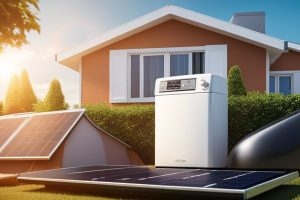What size solar generator do you need to run a house?

Calculating the appropriate size of a solar generator to power your household is crucial for ensuring a reliable and efficient energy supply. Understanding your energy consumption and the capacity of different solar generators is vital in determining the right fit for your home. In this guide, we will break down the factors to consider and provide expert advice on selecting the ideal solar generator size to meet your household’s energy needs.
Key Takeaways:
- Evaluate your power needs: Before determining the size of the solar generator needed to run your house, calculate the total wattage of essential appliances and electrical devices you want to power during an outage.
- Consider battery capacity: Choose a solar generator with a battery capacity that can store enough energy to meet your power needs for the desired duration. Larger battery capacity will allow for longer run times without sunlight.
- Consult a professional: To ensure you select the right size solar generator for your home, consult with a professional solar installer or energy expert who can assess your specific requirements and recommend the optimal system size.
Factors Determining the Size of a Solar Generator
Clearly, determining the size of a solar generator needed to run a house involves considering various factors that impact energy production and consumption. By understanding these key elements, you can accurately size a solar generator to meet your household’s energy needs efficiently.
Household Energy Consumption
To accurately determine the size of a solar generator needed to power your home, you must first assess your household’s energy consumption. Take into account the appliances and electronics you use, as well as the average daily energy usage in kilowatt-hours (kWh). This information will give you a baseline for calculating the size of the solar generator required to meet your power needs.
Recognizing your household’s energy consumption patterns is crucial in sizing a solar generator correctly. By knowing how much energy your house consumes on a typical day, you can select a solar generator with the capacity to handle that load, ensuring uninterrupted power supply.
Peak Sunlight Hours
With solar power systems, the amount of sunlight your location receives plays a significant role in determining the size of the solar generator needed. Peak sunlight hours refer to the hours during the day when sunlight intensity is at its highest, providing maximum energy production potential for solar panels.
Size your solar generator based on the peak sunlight hours in your area to optimize energy production. Areas with longer peak sunlight hours may require smaller solar generators to generate the same amount of energy as locations with shorter peak sunlight hours. Understanding this factor is essential in sizing a solar generator that can efficiently power your home throughout the day.
Types of Solar Generators
Obviously, before determining what size solar generator you need to power your house, it’s important to understand the different types of solar generators available on the market. Solar generators come in various sizes and capacities, each designed for different purposes and applications.
| Portable Generators | Standby Generators |
| Grid-tied Systems | Battery Backup Systems |
| Hybrid Systems | Off-grid Systems |
| Solar Mini-Grids | Solar Home Systems |
| Solar Farm Systems | Solar Power Plants |
Knowing the differences between these types of solar generators will help you determine which one is best suited for your specific energy needs and requirements.
Portable vs. Standby Generators
Generators come in two main categories: portable and standby generators. Portable generators are smaller in size and can be easily moved from one location to another. They are ideal for camping, outdoor events, or as a backup power source during emergencies. On the other hand, standby generators are larger and are permanently installed outside your home. They are designed to automatically kick in when there is a power outage and can power your entire house.
When it comes to choosing between a portable and standby generator, consider your power needs, budget, and how frequently you will need to use the generator. Portable generators are more affordable and versatile, while standby generators offer a more seamless and convenient power backup solution for your home.
Solar Generator Capacity Range
Types of solar generators also vary based on their capacity range. Solar generators can range from small, portable units that can power a few small electronics to large-scale systems that can power an entire house or even a community. The capacity of a solar generator is measured in kilowatt-hours (kWh) and determines how much energy it can store and supply.
With advancements in solar technology, solar generators are becoming more efficient and powerful, allowing homeowners to rely on solar energy as their primary source of electricity. When choosing a solar generator, consider your energy consumption habits, household size, and the amount of sunlight your location receives to determine the appropriate capacity range for your needs.
Step-by-Step Guide to Choosing the Right Size
Keep in mind that determining the right size solar generator to power your house is crucial for ensuring you have enough energy to meet your needs. Below is a step-by-step guide to help you select the appropriate size solar generator for your home.
| Step 1: Assess Your Energy Needs | Step 2: Evaluate Solar Generator Specifications |
| Calculate your daily energy consumption | Check the wattage and battery capacity of the generator |
| Determine peak usage times | Consider the inverter capacity |
| Factor in any future energy needs | Look at the solar panel efficiency and charging capabilities |
Tips for Assessing Your Energy Needs
When assessing your energy needs, consider the appliances and electronics you use on a daily basis. Make a list of each item, its wattage, and the average number of hours it runs per day to calculate your total energy consumption. Additionally, factor in any seasonal variations or future energy needs to ensure you have enough power.
It’s also important to identify any peak usage times when multiple appliances are running simultaneously. This will help you determine the maximum power output your solar generator needs to handle during these periods.
- After assessing your energy needs, you can determine the size of the solar generator required to meet your household’s power requirements.
Evaluating Solar Generator Specifications
Generator specifications such as wattage, battery capacity, inverter capacity, solar panel efficiency, and charging capabilities are crucial factors to consider when choosing the right size solar generator. Make sure the generator you select has the necessary capacity to meet your energy demands and can efficiently convert solar energy into usable electricity.
It’s also essential to consider the physical size and weight of the solar generator, especially if you have limited space for installation. Ensure the generator meets any size or weight restrictions and can be easily integrated into your existing power system.
This comprehensive evaluation of solar generator specifications will help you make an informed decision and select the right size generator to power your house reliably and efficiently.
Pros and Cons of Different Solar Generator Sizes
Despite the many benefits of using a solar generator to power your home, there are also some drawbacks to consider when deciding on the size of your system. Here, we will discuss the pros and cons of different solar generator sizes to help you make an informed decision.
| Pros | Cons |
| Can meet the energy needs of your home effectively | Initial cost can be higher |
| Reduced reliance on the grid | May require more space for installation |
| Increased energy independence | Maintenance costs can add up over time |
| Can potentially increase the value of your home | Performance can vary depending on weather conditions |
| Environmentally friendly energy source | Not suitable for every location due to sunlight availability |
Advantages of Adequate Sizing
Advantages of choosing an adequately sized solar generator include meeting your home’s energy demands efficiently and effectively. By ensuring that your system can generate enough power to cover your needs, you can reduce your reliance on the grid and increase your energy independence.
Additionally, having an appropriately sized solar generator can potentially increase the value of your home while allowing you to enjoy the benefits of environmentally friendly energy. This can be a significant advantage for both your finances and the planet.
Drawbacks of Oversizing or Undersizing
An oversized solar generator may lead to higher initial costs, as you would be investing in more capacity than necessary. On the other hand, undersizing can result in insufficient power generation, leading to reliance on the grid and potential disruptions in your energy supply. Finding the right balance is crucial to maximizing the benefits of solar energy for your home.
Plus, an undersized system may also require frequent maintenance and repairs due to overuse, potentially increasing long-term costs. Conversely, oversizing your solar generator can lead to wasted space and resources without providing significant additional benefits. It is essential to carefully consider your energy needs and usage patterns to determine the most suitable size for your solar generator.
To wrap up
Summing up, determining the size of a solar generator needed to power a house depends on various factors such as the household’s energy consumption, location, and available sunlight. A general guideline is to calculate your average daily electricity usage and choose a solar generator that can meet those needs. It’s essential to consult with a professional to assess your specific requirements accurately and ensure your solar generator can efficiently power your home. Investing in the right size solar generator will help you save money on your electricity bills and reduce your carbon footprint, making it a wise and environmentally friendly choice for any household.
FAQ
Q: What size solar generator do you need to run a house?
A: The size of the solar generator you need to run a house depends on several factors such as the energy consumption of your home, the number of appliances you want to power, and your location’s sunlight exposure. On average, a typical residential home may require a solar generator with a capacity of 5-20 kilowatts to meet its energy needs.
Q: How can I determine the energy consumption of my house?
A: To determine the energy consumption of your house, you should start by conducting an energy audit. This involves identifying all the electrical appliances and devices in your home, tracking their usage patterns, and calculating their power requirements. You can also look at your past utility bills to get an estimate of your monthly energy usage.
Q: What factors should I consider when sizing a solar generator for my house?
A: When sizing a solar generator for your house, you should consider factors such as your average daily energy consumption, the peak power demand of your appliances, the available sunlight in your area, and any future energy needs. It’s recommended to consult with a solar energy expert who can assess your requirements and help you choose the right size generator for your home.
